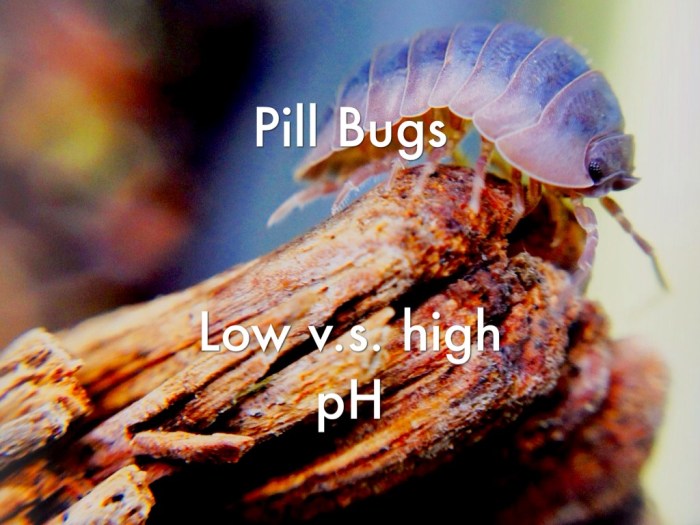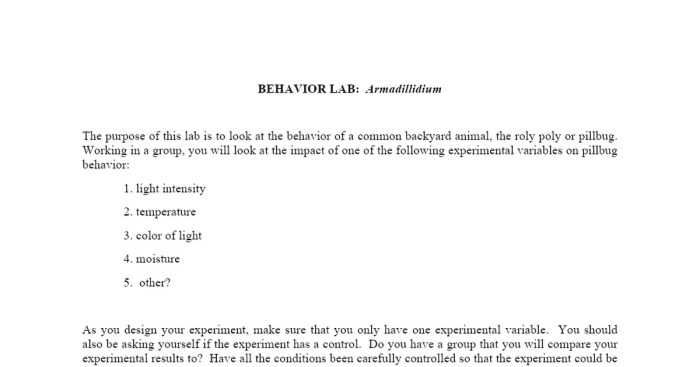Embark on a fascinating exploration into the world of pill bugs, where the answers to their intriguing behaviors await. From their peculiar defense mechanisms to their habitat preferences, this journey into pill bug behavior lab answers promises to captivate your curiosity.
Our investigation begins with a deep dive into the experimental methods employed to study these enigmatic creatures. We’ll uncover the importance of controlling variables and the step-by-step procedures that guide researchers in their quest to unravel the mysteries of pill bug behavior.
Pill Bug Behavior

Pill bugs, also known as roly-polies or woodlice, are terrestrial crustaceans belonging to the order Isopoda. They are fascinating creatures with unique behaviors that have adapted to their specific environments.
To satisfy your scientific curiosity, check out our comprehensive guide to pill bug behavior lab answers. After exploring the intriguing world of pill bugs, why not test your pop culture knowledge with our challenging WWE quiz ? Once you’ve named all the wrestling superstars, return to our lab answers to delve deeper into the fascinating behavior of pill bugs.
Pill bugs are generally scavengers and feed on decaying plant matter, fungi, and algae. They prefer moist, dark habitats such as under rocks, logs, or leaf litter, where they can avoid predators and find ample food sources.
One of the most distinctive behaviors of pill bugs is their ability to roll up into a tight ball when threatened. This defense mechanism protects their vulnerable underside from predators and helps them escape danger.
Pill Bug Species and Unique Behaviors, Pill bug behavior lab answers
There are over 4,000 species of pill bugs worldwide, each with its own unique characteristics and behaviors.
- Armadillidium vulgare:This common pill bug species is known for its ability to roll up tightly and remain in a ball for extended periods.
- Porcellio scaber:Also known as the common rough woodlouse, this species is larger than most pill bugs and has a rougher exoskeleton.
- Armadillidium nasatum:This pill bug species has a distinctive “nose” on its head and is found in moist, forested areas.
- Cylisticus convexus:This species of pill bug is known for its ability to jump when disturbed.
Lab Experiments
Conducting lab experiments is a crucial aspect of studying pill bug behavior. These experiments allow researchers to control variables, observe specific behaviors, and draw conclusions about the factors influencing those behaviors.
To ensure the validity and reliability of experimental results, it is essential to control variables that may affect pill bug behavior. These variables include temperature, humidity, light, and food availability. By controlling these variables, researchers can isolate the effects of specific experimental treatments on pill bug behavior.
Appropriate experimental designs are also crucial for obtaining meaningful results. Researchers typically use controlled experiments, in which one group of pill bugs is exposed to the experimental treatment while another group serves as a control. The control group is not exposed to the experimental treatment and provides a baseline for comparison.
Step-by-Step Procedures
Here are the step-by-step procedures for conducting a lab experiment on pill bug behavior:
- Define the research question: Clearly state the specific question you aim to answer through the experiment.
- Design the experiment: Choose an appropriate experimental design, control variables, and establish treatment groups.
- Collect pill bugs: Collect pill bugs from a suitable habitat and ensure they are healthy and representative of the population being studied.
- Set up the experimental environment: Create an environment that controls variables such as temperature, humidity, and light.
- Expose pill bugs to experimental treatments: Introduce the experimental treatment to the treatment group while leaving the control group unexposed.
- Observe and record pill bug behavior: Systematically observe and record pill bug behaviors relevant to the research question, using appropriate methods such as video recording or direct observation.
- Analyze the data: Use statistical methods to analyze the data and determine whether there are significant differences between the treatment and control groups.
- Draw conclusions: Based on the data analysis, draw conclusions about the effects of the experimental treatment on pill bug behavior.
Data Collection and Analysis

Data collection and analysis are crucial steps in understanding pill bug behavior. Researchers employ various techniques to gather data, including:
Observation
Observational studies involve watching and recording pill bug behavior in their natural or controlled environments. This method provides insights into their natural behaviors, such as movement patterns, food preferences, and social interactions.
Tracking
Tracking involves following individual pill bugs over time to monitor their movements, habitat use, and interactions with other individuals. This technique can reveal patterns in their behavior and provide information about their home range and dispersal patterns.
Video Recording
Video recording allows researchers to capture and analyze pill bug behavior in detail. This method enables researchers to study specific behaviors, such as mating rituals, courtship displays, and predator avoidance strategies.
Once data is collected, researchers use statistical tests and graphical representations to analyze it. Statistical tests, such as t-tests and chi-square tests, can identify significant differences in behavior between different groups or conditions.
Graphical representations, such as bar charts and line graphs, can help visualize data patterns and identify trends. For example, data analysis can reveal insights into:
- The effect of light intensity on pill bug movement patterns
- The relationship between humidity and pill bug aggregation behavior
- The influence of food availability on pill bug reproductive success
Factors Influencing Pill Bug Behavior: Pill Bug Behavior Lab Answers

Environmental and internal factors significantly impact pill bug behavior. These factors include temperature, humidity, light, hunger, thirst, and stress.Environmental factors play a crucial role in shaping pill bug behavior. For instance, temperature affects their activity levels, with pill bugs becoming more active in warmer temperatures.
Humidity influences their water balance, as pill bugs tend to inhabit moist environments to prevent desiccation. Light also affects their behavior, as pill bugs exhibit negative phototaxis, meaning they avoid bright light.Internal factors also influence pill bug behavior. Hunger, for example, drives pill bugs to seek food, while thirst motivates them to find water sources.
Stress, caused by factors such as overcrowding or predators, can alter their behavior, making them more defensive or withdrawn.The interaction of different factors can further influence pill bug behavior. For example, when temperature and humidity are both high, pill bugs may become more active in search of food and water.
Conversely, when temperature and humidity are low, they may exhibit reduced activity and seek shelter to conserve energy and moisture.
Commonly Asked Questions
What is the significance of pill bug behavior research?
Pill bug behavior research provides valuable insights into animal behavior, contributing to our understanding of how organisms interact with their environment and adapt to different conditions.
How are pill bug behavior experiments conducted?
Pill bug behavior experiments involve carefully controlled laboratory conditions, where researchers manipulate environmental variables and observe the responses of the pill bugs.
What are some practical applications of pill bug behavior research?
Pill bug behavior research has practical implications in pest control, aiding in the development of effective strategies to manage these common household invaders.